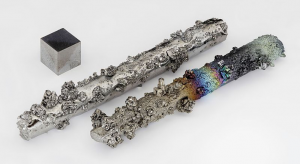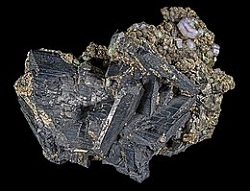Tungsten
What is Tungsten?
Tungsten is a transition metal in nature that has a shiny, silvery-gray appearance. Pure tungsten is brittle but hard. It has many uses, including lighting, improved alloys, jewelry, and medical research.
Tungsten’s Place in the Periodic Table
![]() Tungsten is a transition metal in group 6 and period 6. Transition metals are those found in groups 3 to 12 of the periodic table and they have partially filled d-orbitals. In nature, tungsten is rare but exists in compounds with other elements. As you can see on the periodic table, the symbol for tungsten is not derived from its name. The W is derived from the name of the mineral in which it can be found: wolframite.
Tungsten is a transition metal in group 6 and period 6. Transition metals are those found in groups 3 to 12 of the periodic table and they have partially filled d-orbitals. In nature, tungsten is rare but exists in compounds with other elements. As you can see on the periodic table, the symbol for tungsten is not derived from its name. The W is derived from the name of the mineral in which it can be found: wolframite.
- Atomic number: 74
- Atomic Radius: 139 picometers
- Atomic mass: 183.84
- Symbol: W
- Group: 6
- Period: 6
- Number of Protons: 74
- Number of Electrons: 74
- Number of Neutrons: ~110
- Number of Isotopes: 5 natural isotopes
Properties of Tungsten
 Tungsten is well known for having the highest melting and boiling points of any element discovered so far. Its density is also very stable at these temperatures, and so it does not easily expand or contract on heating or cooling. It does not react easily with oxygen, acids, or bases. It is stable at a wide range of temperatures and forms a thin film of tungsten oxides as tarnish on its surface. Tungsten is a good conductor of heat and electricity. It exists in nature as oxides and is found with iron, magnesium, and calcium. It is the only transition metal known to have a biological function. It is used by some bacteria as a factor required for metabolism. Although it is not immediately toxic, it has been linked to cancer in humans.
Tungsten is well known for having the highest melting and boiling points of any element discovered so far. Its density is also very stable at these temperatures, and so it does not easily expand or contract on heating or cooling. It does not react easily with oxygen, acids, or bases. It is stable at a wide range of temperatures and forms a thin film of tungsten oxides as tarnish on its surface. Tungsten is a good conductor of heat and electricity. It exists in nature as oxides and is found with iron, magnesium, and calcium. It is the only transition metal known to have a biological function. It is used by some bacteria as a factor required for metabolism. Although it is not immediately toxic, it has been linked to cancer in humans.
Physical Properties
Tungsten is solid at room temperature and has a similar density to gold. It melts at 3422°C, which is close to the melting point of diamonds. Diamonds are made of pure carbon but don’t actually have a real melting point. That is because at this temperature diamonds sublime, which is the phase transition of a solid to a gas. Therefore, tungsten has the highest melting point of any element. It vaporizes at 5930°C – hotter than the surface of the sun!
- Melting Point: 3422°C.
- Boiling Point: 5930°C.
- Density of Solid Tungsten: 3 g cm-3.
- Phase at Room Temperature: solid
Chemical Properties
 Tungsten has two valence electrons and 4 electrons in its 5d orbital. It is most stable when these electrons are shared with another element, so it exists most commonly in the +6 oxidation state. Tungsten is highly resistant to oxidation, and reactions with acids and bases. Therefore, it forms a limited number of compounds in nature.
Tungsten has two valence electrons and 4 electrons in its 5d orbital. It is most stable when these electrons are shared with another element, so it exists most commonly in the +6 oxidation state. Tungsten is highly resistant to oxidation, and reactions with acids and bases. Therefore, it forms a limited number of compounds in nature.
- Oxidation states: -4, -2, -1, 0, +1, +2, +3, +4, +5, +6
- Specific Heat: 196 J kg-1K-1
- Electronegativity: 1.17 (Pauling scale)
- Heat of Fusion: 62 kj mol-1
- Heat of Vaporization: 192 kj mol-1
- Electron Configuration: [Xe] 4f145d46s2
Isotopes
Five isotopes of tungsten exist in nature: Tungsten-180 (abundance = 0.12%), -182 (26.5%), -183 (14.31%), -184 (30.64%), -186 (28.43%). Tungsten-180 is slightly radioactive but otherwise stable with a half-life of thousands of billions of years. Thirty-three artificial isotopes have been created in laboratories and range from tungsten-157 to tungsten-194. These have half-lives ranging from days to microseconds. Their decay products include the elements hafnium (Hf), tantalum (Ta), and rhenium (Re). Tungsten-180 is used to create tungsten-181 by neutron bombardment. Tungsten-181 is used in radiation therapy.
Alloys and Allotropes
Alloys of tungsten are known for their strength and resistance to heat. Tungsten carbide is harder than steel. Steel is an alloy of iron and carbon. Tungsten can be added to steel to form a harder steel known as high speed steel. Mallory metal is an alloy of tungsten and iron that has twice the density of standard steel.
Compounds of Tungsten
Polyatomic ions are ions that contain more than one atom. For example, Na+ is a monoatomic ion, and NO3– (nitrate) is a polyatomic ion. In nature, tungsten can form polyatomic ions as tungsten oxides in a complex lattice structure with phosphate or silicate. One example is the phosphotungstate anion, which is used in the production of fabric dyes. Tungsten (IV) oxide is used to fireproof fabric. Tungsten (III) oxide is used in coating materials to absorb infrared light.
Interesting Facts about Tungsten
- Hard tungsten alloys are used in missiles to penetrate armored military equipment.
- Due to its high density, tungsten is useful to create smaller ballasts. Ballasts are heavy materials that are used to improve the stability of moving objects like race cars, sail boats, and commercial planes.
- Because tungsten has a density similar to gold, counterfeit gold bars are made by coating tungsten bars with a small layer of gold. Tungsten jewelry can also be coated with gold to create counterfeit jewelry.
Occurrence and Abundance of Tungsten
Tungsten is most commonly found in a mineral called wolframite. Wolframite contains tungsten oxide, iron, and manganese. Tens of thousands of tons of tungsten are produced every year from its mineral sources. Tungsten makes up 0.00011 % of the Earth’s crust and 5×10-8 % of the universe. It is produced as a powder because its high melting temperature makes it too expensive to melt into molds. China is the largest producer of tungsten but there are tungsten mines across the globe. Tungsten is known as a conflict mineral because of unethical mining practices that have funded war in the Democratic Republic of the Congo.
Uses of Tungsten
Most Notable Uses in General
 Tungsten carbide is used to make metallic tungsten rings for the jewelry trade. Addition of nickel makes the jewelry more lustrous or shiny. Because tungsten rings are very hard, they resist scratches from everyday wear and tear. Tungsten is also useful in jewelry because it is hypoallergenic. Tungsten oxides, known as tungstates, are used for ceramic glazes. Calcium and magnesium tungstate are used in fluorescent lights. Cutting tools can be made from high speed steel, which contains tungsten, to cut hard metals.
Tungsten carbide is used to make metallic tungsten rings for the jewelry trade. Addition of nickel makes the jewelry more lustrous or shiny. Because tungsten rings are very hard, they resist scratches from everyday wear and tear. Tungsten is also useful in jewelry because it is hypoallergenic. Tungsten oxides, known as tungstates, are used for ceramic glazes. Calcium and magnesium tungstate are used in fluorescent lights. Cutting tools can be made from high speed steel, which contains tungsten, to cut hard metals.
Most Notable Uses in Science
Tungsten is used as an electron acceptor of X-rays. Therefore, it is used in radiation shields to protect people from samples of radioactive material. It is also used in electron telescopes on space ships that detect cosmic rays from the Sun.
Discovery of Tungsten
Carl Wilhelm Scheele discovered tungstic acid in 1781, and suggested that the compound might be made up of a new element. At the time, tungstic acid was used to dye fabrics. Two brothers from Spain, Jose and Fausto Elhuayer, reacted carbon with tungstic acid to isolate tungsten. They named it wolfram after the primary tungsten mineral, wolframite.
Tungsten in the Future
Tungsten polyanions are being studied for their use as anti-cancer drugs that suppress tumor growth. They have also been shown to disrupt the accumulation of proteins in the brain that cause Alzheimer’s. They are also being used in the development of alternatives to toxic, chlorine-based bleaching for paper production.